
In 2003, ‘Purple Majesty’ took the gardening world by storm when it was a 2003 All-America Selections Gold Medal Winner. Since then several other selections of Pennisetum glaucum have been developed as ornamentals. P. glaucum, sometimes called cattail, bulrush, or pearl millet, is one of the world’s oldest cultivated grains, grown as a food or forage crop in Africa and the Indian subcontinent since prehistoric times (but most commonly seen in the US as the small round white seed in birdseed mixes). The plant resembles maize or corn but all of the ornamental types were selected for their attractive foliage and inflorescences rather than for crop yield. The original cultivar,
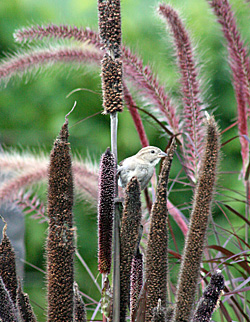
‘Purple Majesty’, was developed from selections in a grain millet-breeding program at the University of Nebraska, where it stood out among the normal plants with green foliage. This and several other more recently developed cultivars make striking accent plants in the garden.
P. glaucum is an annual warm-season grass that grows 2-5 feet tall. This upright bunch grass tillers (makes secondary shoots) freely and produces several stems from the base of the plant. The stems ½ to 1 inch in diameter and the leaves are 1½ to 3 inches wide and anywhere from 8 to 40 inches long, depending on the cultivar. It has an extensive root system that makes it drought tolerant. In summer it produces foot-long bottle brush-like inflorescences (single racemes) on the ends of the stems. The “fruits” that follow are cylindrical white, yellow, brown or purple.
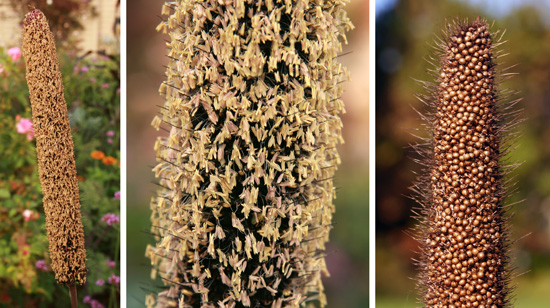
This ornamental is easily grown from seed. Seeds germinate in a few days under warm conditions. They are best started indoors a few weeks before the average date of last frost (preferably at 72 to 78°F; temperatures below 68°F will significantly delay germination and growth), and transplanted outdoors after the soil has warmed. As it is tropical in origin, it will not do much until the weather warms but then will grow quickly.
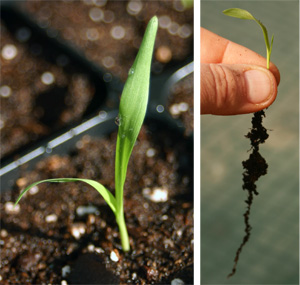
The optimum temperature for growth is 91 to 95°F so it may never achieve maximum size in cool summers in the Midwest. Provide as much light as possible, as higher light results in stronger and thicker stems and more tillers. Seeds should not be started too early, as the plants will be stunted if they become root bound and the growth of the main shoot is slowed or stopped (although the sideshoots will develop normally once transplanted). Shorter plants will result from excessively root bound plants or those flowering prior to planting in the landscape.

They can be sown directly outdoors after the soil has warmed but may not have enough time to mature in areas with a short growing season. Plants develop sturdy stalks that rarely need staking despite growing several feet tall. Each plant has 1 to 3 main stems, and may also develop several tillers. In late summer plants produce 12-14″ inflorescences that resemble a cattail. The plants do best in light, well-drained soils, but most selections tolerate almost any type of soil.
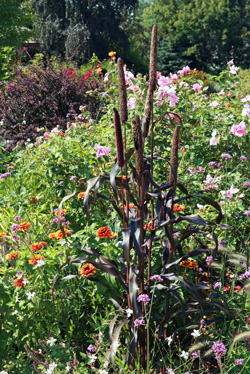
They are also best planted in full sun; purple cultivars need full sun to develop deep color. P. glaucum will tolerate poor soils and dry conditions, but will grow more vigorously with early fertilizer applications and consistent watering. Ornamental millet has few pests but occasionally aphids will infest the plants.
The ornamental selections of millet are suitable for growing as vertical accent plants in containers or garden beds and borders. They are best planted in clumps or masses rather than as individual plants. The tall cultivars make striking backdrop plantings while the shorter types are better used as accents or edges in the front. All of the cultivars work well in large mixed containers, where they create a tropical look. Dark purple cultivars make an intense contrast to bright orange flowers, and yellow to light green flowers or foliage, including the chartreuse blossoms of Nicotiana langsdorfii.
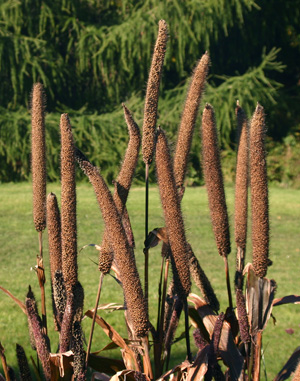
Surround them with pink petunias or green zinnias, or try them with silver-foliaged plants such as dusty miller. For more restful combinations choose soft pink or lavender-colored flowers. Green-leaved cultivars give a completely different look, while short varieties mix better with lower plants, often in smaller spaces. Birds, including goldfinches and sparrows, will eat the seeds so you may want to leave the plants in place longer than most annuals. There is no concern with self seeding in areas with cold winters as the seeds will not survive freezing temperatures. The young flower spikes can be used as cut flowers and mature seed heads are good additions to dried arrangements.
-

‘Purple Majesty’ ornamental millet.
‘Purple Majesty’ is a tall F1 hybrid with deep purple foliage, stems and flower plumes. The mature leaves are long and slender, with a red midrib. This striking plant is reminiscent of a purple cornstalk with stiff, 8-15″ purple plumes covered in golden pollen when in bloom. It makes a great contrast to plants with green foliage and mounding or spreading habits. The purple color combines well with other plants that flower in pink or orange tones. Plants grow 4-5 feet tall and up to 3 feet wide (although frequently are more slender than that), starting out with juvenile green foliage as seedlings but developing the dark coloration as they mature (once they have about 8 leaves). -
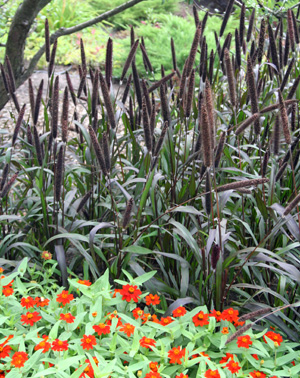
‘Purple Barron’ ornamental millet.
‘Purple Barron’ is similar to ‘Purple Majesty’ but is more compact (only about 3 feet tall), slightly darker in color, and with shorter and wider leaves. The plants also tend to produce more tillers at the base than ‘Purple Majesty’, but just like that cultivar, juvenile plants are green and the dark color develops as the plants mature. With a shorter stature, it often fits better in containers, small gardens and with lower plants. -

Purple Jester ornamental millet.
‘Purple Jester’ is another 3 foot tall cultivar with dark foliage in shades of burgundy, green and chartreuse that flowers a week or so later that the previous cultivars, with purple flower spikes. It also tillers freely, forming a bushy plant.
-
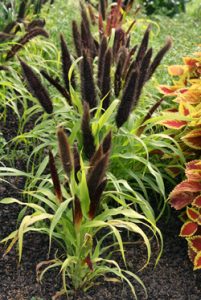
Jade Princess ornamental millet.
‘Jade Princess’ is a compact cultivar, reaching about 2 feet tall, with chartreuse rather than purple foliage, and dark-colored, pollen-less flower spikes. Deadheading the flower spikes before seeds begin to form will keep plants in bloom all season long. It has fountain-like form, so does not provide the strong vertical element the taller types will.
– Susan Mahr, University of Wisconsin – Madison





 Marigolds
Marigolds Create a Butterfly Garden
Create a Butterfly Garden Plant Flowers to Encourage Beneficial Insects
Plant Flowers to Encourage Beneficial Insects Forcing Bulbs
Forcing Bulbs


